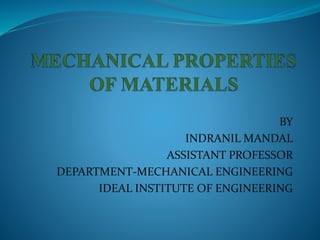
Mechnical properties of Materials
- 1. BY INDRANIL MANDAL ASSISTANT PROFESSOR DEPARTMENT-MECHANICAL ENGINEERING IDEAL INSTITUTE OF ENGINEERING
- 2. ENGINEERING MATERIALS The substances which are useful in the field of engineering are called Engineering materials. A particular material is selected is on the basis of following considerations: 1. Properties of material: Mechanical properties - strength, ductility, toughness, hardness, strength to weight ratio etc. Physical properties - density, specific heat, thermal expansion, conductivity , melting point etc. Chemical properties - oxidation , corrosion, flammability, toxicity etc. Manufacturing properties - formed, casting, machined, welding
- 3. 2. Cost of material 3. Availability of material (desired shape and size and quantity) & reliability of supply. 4. Service in life of material Dimensional stability of material wear, corrosion etc., shorten life 5. Appearance of material Color Surface texture etc.
- 5. MECHANICAL PROPERTIES OF MATERIALS The characteristics of material that describe the behavior under the action of external loads are referred as its mechanical properties. The common mechanical properties are as follows: STRENGTH: It is defined as the ability of a material to resist loads without failure. It is usually expressed or measured in terms of maximum load per unit area (i.e maximum stress or ultimate strength) that a material can withstand failure and it varies according to the type of loading . Further the strength is divided into three types they are: TENSILE STRENGTH: The tensile strength or tenacity is defined as the ability of material to resist a stretching (tensile) load without fracture.
- 6. COMPRESSIVE STRENGTH : The ability of a material to resist squeezing (compressive) load without fracture is called compressive strength. SHEAR STRENGTH : The ability of a material to resist transverse loads i.e. loads tending to separate (or cut) the material is called shear strength. STIFFNESS : It is the ability of material to resist deformation or deflection under load. Within the elastic limit, stiffness is measured by the modulus of elasticity. Shear strength Compressive strength
- 7. ELASTICITY : It is the property of a material to regain its original shape after deformation when the external forces are removed. This property is desirable for materials used in tools and machines. It may be noted that steel is more elastic than rubber. PLASTICTY : It is property of a material which retains the deformation produced under load permanently. This property of the material is necessary for forgings, in stamping images on coins and in ornamental work. DUCTILITY : It is the property of a material enabling it to be drawn into wire with the application of a tensile force. A ductile material must be both strong and plastic. The ductility is usually measured by the terms, percentage elongation and percentage reduction in area. The ductile material commonly used in engineering practice (in order of diminishing ductility) are mild steel, copper, aluminium, nickel, zinc, tin and lead. Ductility
- 8. MALLEABILTY : It is a special case of ductility which permits materials to be rolled or hammered into thin sheets. A malleable material should be plastic but it is not essential to be so strong. The malleable materials commonly used in engineering practice (in order of diminishing malleability) are lead, soft steel, wrought iron, copper and aluminium. TOUGHNESS : It is the property of a material to resist fracture due to high impact loads like hammer blows. The toughness of the material decreases when it is heated. It is measured by the amount of energy that a unit volume of the material has absorbed after being stressed upto the point of fracture. This property is desirable in parts subjected to shock and impact loads. BRITTLENESS : It is the property of a material opposite to ductility. It is the property of breaking of a material with little permanent distortion. Brittle materials when subjected to tensile loads, snap off without giving any sensible elongation. Cast iron is a brittle material.
- 9. HARDNESS : It is defined as the ability of a material to resist scratching or indentation by another hard body. Hardness is directly related to strength.
- 15. CREEP : When a part is subjected to a constant stress at high temperature for a long period of time, it will undergo a slow and permanent deformation called creep. This property is considered in designing internal combustion engines, boilers and turbines. FATIGUE : When a material is subjected to repeated stresses, it fails at stresses below the yield point stresses. Such type of failure of a material is known as fatigue. The failure is caused by means of a progressive crack formation which are usually fine and of microscopic size. This property is considered in designing shafts, connecting rods, springs, gears, etc. RESILIENCE : It is the property of a material to absorb energy and to resist shock and impact loads. It is measured by the amount of energy absorbed per unit volume within elastic limit. This property is essential for spring materials.
- 16. MACHINABILITY: It is the property of a material which refers to a relative case with which a material can be cut. The machinability of a material can be measured in a number of ways such as comparing the tool life for cutting different materials or thrust required to remove the material at some given rate or the energy required to remove a unit volume of the material. It may be noted that brass can be easily machined than steel. WELDABILITY: It is the ability of material to be joined by welding. Weldability depends on chemical composition, physical properties and heat treatment to which they are subjected. CASTABILITY : Castability of metal refer to the ease with which it can be cast into different shapes and is concerned with the behavior of metal in its molten state. STRAIN HARDENING : The strengthening effect produced in metals by plastic deformation( cold working ) is called strain hardening or work hardening. Strain hardening reduces ductility and corrosion resistance but, raises the hardness and electrical resistance.
